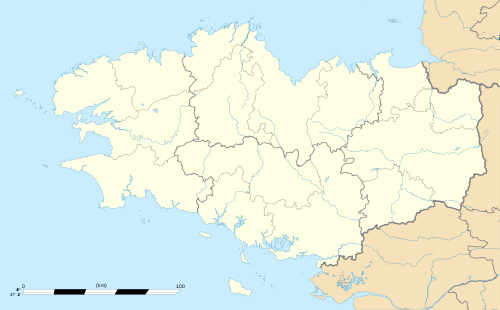Mauron
| Mauron Maoron | ||
|---|---|---|
| Commune | ||
|
The Church of Saint-Pierre, in Mauron | ||
| ||
 Mauron Location within Brittany region  Mauron | ||
| Coordinates: 48°04′59″N 2°17′05″W / 48.0831°N 2.2847°WCoordinates: 48°04′59″N 2°17′05″W / 48.0831°N 2.2847°W | ||
| Country | France | |
| Region | Brittany | |
| Department | Morbihan | |
| Arrondissement | Pontivy | |
| Canton | Ploërmel | |
| Intercommunality | Mauron en Brocéliande | |
| Government | ||
| • Mayor (2008—2014) | Christian Perrocheau | |
| Area1 | 67.23 km2 (25.96 sq mi) | |
| Population (1999)2 | 3,196 | |
| • Density | 48/km2 (120/sq mi) | |
| Time zone | UTC+1 (CET) | |
| • Summer (DST) | UTC+2 (CEST) | |
| INSEE/Postal code | 56127 /56430 | |
| Elevation | 47–130 m (154–427 ft) | |
|
1 French Land Register data, which excludes lakes, ponds, glaciers > 1 km2 (0.386 sq mi or 247 acres) and river estuaries. 2 Population without double counting: residents of multiple communes (e.g., students and military personnel) only counted once. | ||
Mauron (Breton: Maoron) is a commune in the Morbihan department of Brittany in north-western France. It is also in the liminal area of both Côtes d'Armor and l'Ille-et-Vilaine. Its central location has made it a crossroads on the axes connecting Dinan to Vannes and Rennes to Quimper.
History
Aerial archaeology reveals a large number of Gallic farms, which attest to the agricultural wealth of the territory, which is crossed by the Roman road leading from Rennes to Quimper.
St. Judicaël founded a monastery in the area, at a place called Saint-Léry.
The first historical mention of Mauron dates from 1152. In the eighteenth century, a fair was held there on October 28 every year, which is the feast of St. Simon.
Battle of Mauron
On August 14, 1352, six hundred French Bretons (who supported King John II of France, the protector of Charles of Blois), under the leadership of the marshal of Offemont, fought Anglo-Breton troops (who supported the Montfort side) which was led by Gaultier de Genteley (or Venteley, or Benteley). He was assisted by Tanguy du Chastel, Yves Trésiguidy and Garnier de Cadoual. The location of the battle appears to be near the village of Bois-de-la-Roche.
The king's troops lost the battle on August 14, 1352. Many corpses were left on the field of battle, including the marshal of Offemont, the comte of Marche, the lords Bricquebec, Beauvais, Alain VII (11th vicomte Rohan), Tinténiac and a significant number of knights (around 140).
Demographics
The inhabitants of Mauron are known in French as Mauronnais. In 2006, the commune consisted of 3,097 inhabitants. Population censuses have been conducted in the town since 1793.
Breton language
In 2008, 6.4% of local children attended bilingual primary schools.[1]
Sites and Monuments
Religious
- Church of St. Peter
- Monastery of l'Action de Grâces, founded by Virginie Danion, a native of Mauron, in 1869. A painting by Alphonse Le Hénaff can be found in the chapel.
- Chapel of St. Anne, of the 17th century, in the village of Beuve, near the site of a chateau which was destroyed in 1676.
Civil
- Chateau de Boyer
- Chateau de La Ville-Davy
- Chateau du Ferron
- Departure point for the "Voie verte Mauron Questembert" (a footpath from Mauron to Questembert), which was an idea formulated by Morbihan's general council and opened in 2002. It uses the ancient route of the railway line from La Brohinière - Ploërmel and then Questembert - Ploërmel line.
Personalities connected to the commune
- The playwright Romain Weingarten (1926-2006) is buried in Mauron, to where he had retired at the end of his life.
- Virginie Danion, founder of the monastery of l'Action de Grâces and sister-in-law of the architect Sigismond Ropartz,
Twin towns
See also
References
- Mayors of Morbihan Association (in French)
- INSEE commune file
- ↑ (in French) Ofis ar Brezhoneg: Enseignement bilingue
External links
| Wikimedia Commons has media related to Mauron. |
- Official site (in French)
- French Ministry of Culture list for Mauron (in French)
- Map of Mauron on Michelin (in English)
- Patrimonial Encyclopaedia of the Community of Communes of Mauron in Brocéliande (in French)
.svg.png)